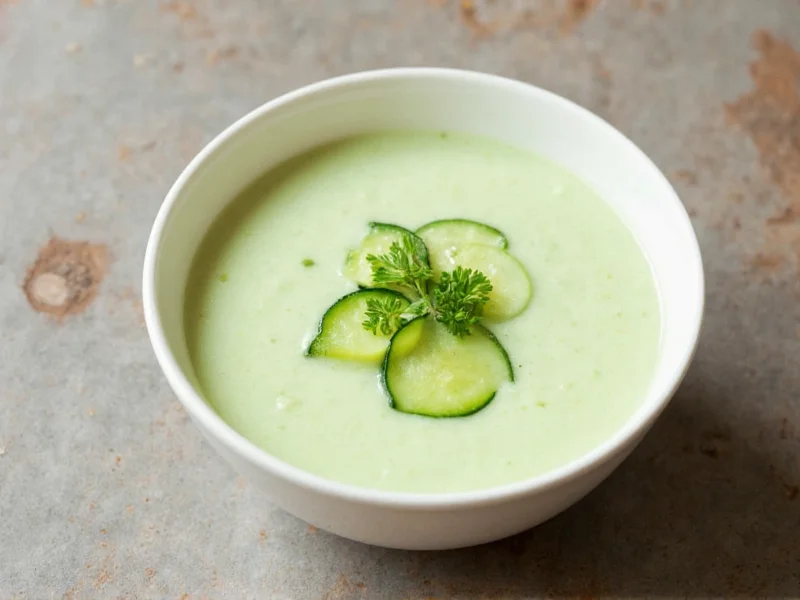Cold cucumber soup has become a summer staple worldwide, but its roots trace back to traditional Spanish gazpacho and Eastern European okroshka. Unlike tomato-based gazpacho, cucumber-focused versions highlight the vegetable's natural cooling properties and mild flavor profile. This soup shines during hot months when heavy meals feel unappealing, offering hydration and nutrition without requiring stove time.
Why Cucumber Soup Belongs in Your Summer Rotation
Cucumbers contain 95% water, making them nature's hydration solution. When transformed into soup, they deliver electrolytes like potassium while remaining incredibly low-calorie—typically under 100 calories per serving. The addition of Greek yogurt provides protein and probiotics, creating a nutritionally balanced dish that satisfies without weighing you down.
Selecting Ingredients for Maximum Flavor
Not all cucumbers work equally well in cold soup. English cucumbers (often sold shrink-wrapped) contain fewer seeds and thinner skins than standard varieties, yielding a smoother texture with less bitterness. If using regular cucumbers, peel thoroughly and scoop out the seed cavity.
| Ingredient | Quality Indicator | Substitution Options |
|---|---|---|
| English cucumbers | Firm, dark green skin without yellowing | Persian cucumbers (smaller size) |
| Greek yogurt | Thick consistency, plain/unflavored | Silken tofu, coconut milk (dairy-free) |
| Fresh dill | Vibrant green, crisp stems | Mint or basil (for different flavor profile) |
Step-by-Step Preparation Guide
Follow this method for perfectly balanced cold cucumber soup:
- Peel and roughly chop 2 pounds of English cucumbers
- Combine with 1 cup Greek yogurt, 1 minced garlic clove, 2 tbsp lemon juice, 2 tbsp fresh dill, ½ tsp salt, and ¼ tsp white pepper
- Blend until completely smooth (2-3 minutes)
- Strain through fine mesh sieve to remove any fibrous bits
- Chill for minimum 4 hours (overnight yields best flavor integration)
- Adjust seasoning and thin with cold water if needed before serving
Regional Variations Worth Trying
While the basic formula remains consistent, cultural adaptations offer exciting twists:
- Spanish-inspired: Add ½ cup diced bell pepper and 1 tbsp sherry vinegar for a gazpacho hybrid
- Middle Eastern: Incorporate 1 tbsp tahini and top with sumac-spiced yogurt
- Asian fusion: Replace yogurt with coconut milk and add ginger and lime juice
- Provençal: Mix in chopped chives and tarragon with a drizzle of olive oil
Serving Techniques That Elevate the Experience
Temperature and presentation significantly impact enjoyment. Serve at 40-45°F (4-7°C)—colder than refrigerator temperature but not icy. Pour into pre-chilled bowls and consider these finishing touches:
- Top with diced cucumber for contrasting texture
- Add edible flowers like nasturtiums for visual appeal
- Drizzle with high-quality extra virgin olive oil
- Sprinkle with toasted sesame seeds or chopped pistachios
Common Preparation Mistakes to Avoid
Even simple recipes encounter pitfalls. Prevent these issues:
- Watery consistency: Salt cucumbers and let drain 20 minutes before blending to draw out excess moisture
- Bitter flavor: Remove the dark green skin completely and avoid the seed cavity where bitterness concentrates
- Dull color: Blend immediately after cutting cucumbers—oxidation causes discoloration
- Flat seasoning: Balance acidity with lemon juice and sweetness with a pinch of sugar if needed
Storage Guidelines for Optimal Freshness
Cold cucumber soup maintains quality for 3-4 days in airtight containers. The yogurt base prevents separation better than dairy-free alternatives. For best results:
- Store without garnishes (they become soggy)
- Place plastic wrap directly on soup surface to prevent oxidation
- Avoid freezing (yogurt separates upon thawing)
- Stir well before serving as natural separation occurs
Perfect Pairings for Complete Meals
While delicious alone, cold cucumber soup complements various dishes:
- Grilled shrimp skewers with lemon-herb marinade
- Crusty bread with whipped feta cheese
- Simple green salad with vinaigrette dressing
- Quiche Lorraine for a more substantial lunch
Frequently Asked Questions
Can I make cold cucumber soup without yogurt?
Yes, substitute yogurt with silken tofu blended until smooth, coconut milk for dairy-free option, or vegetable broth for lighter consistency. Each alternative requires slight seasoning adjustments to maintain balance.
Why does my cold cucumber soup taste bitter?
Bitterness comes from cucumber skins and seed cavities. Always peel thoroughly and scoop out seeds before blending. English cucumbers contain less bitterness than standard varieties. Salting and draining chopped cucumbers for 20 minutes also draws out bitter compounds.
How far in advance can I prepare cold cucumber soup?
For best flavor and texture, prepare cold cucumber soup 12-24 hours before serving. The flavors meld beautifully during this time. Avoid making more than 48 hours ahead as cucumbers oxidize and lose vibrancy. Store with plastic wrap pressed directly on the soup surface to prevent discoloration.
What's the difference between cucumber soup and gazpacho?
Traditional gazpacho centers on tomatoes with cucumber as optional addition, while cold cucumber soup features cucumber as the primary ingredient. Gazpacho typically includes bell peppers and stale bread for thickness, whereas cucumber soup relies on yogurt or similar thickeners. Both are served chilled but represent distinct culinary traditions.











 浙公网安备
33010002000092号
浙公网安备
33010002000092号 浙B2-20120091-4
浙B2-20120091-4